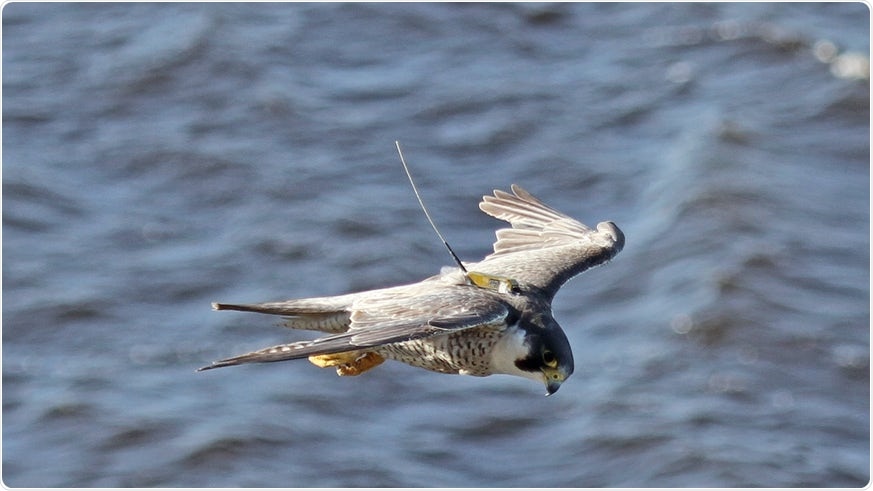Researchers from the Chinese Academy of Sciences and Cardiff University have reported that they have found the strongest proof yet of a “migration gene” in birds.

A tagged peregrine falcon. Image Credit: Andrew Dixon.
The researchers detected a single gene linked to migration in peregrine falcons by monitoring them through satellite technology and integrating this data with genome sequencing.
According to the researchers, their discoveries provide additional evidence to indicate that genetics play a crucial role in the distance of migration paths.
Recently published in the Nature journal, the study also looked at the estimated effect of climate change on migration-and how this is likely to interact with evolutionary factors.
The investigators tagged a total of 56 Arctic peregrine falcons and monitored their routes through satellite, tracking their yearly flight directions and distances thoroughly.
The team observed that the studied peregrine falcons utilized five migration paths across Eurasia, perhaps established between the last ice age 22,000 years ago and the middle-Holocene 6,000 years ago.
The researchers employed whole genome sequencing and detected a gene, called ADCY8, which is known to play a key role in long-term memory in other animals, and linked to variations in migratory distance.
They discovered that the ADCY8 gene had a variant at high frequency in long-distance (eastern) migrant populations of peregrine falcons, suggesting that this variant is being preferentially chosen because it may boost the powers of long-term memory believed to be crucial for migration across a long distance.
Previous studies have identified several candidate genomic regions that may regulate migration—but our work is the strongest demonstration of a specific gene associated with migratory behaviour yet identified.”
Mike Bruford, Study Author and Professor, Molecular Ecologist, School of Biosciences, Cardiff University
The team also analyzed the replications of likely future migration behavior to foretell the global warming impact.
If the climate continues to warm at the same pace it has in recent years, the team believes that peregrine populations in western Eurasia will have a maximum chance of population decline and may cease migrating altogether.
In this study we were able to combine animal movement and genomic data to identify that climate change has a major role in the formation and maintenance of migration patterns of peregrines.”
Mike Bruford, Study Author and Professor, Molecular Ecologist, School of Biosciences, Cardiff University
Xiangjiang Zhan, an honorary visiting professor at Cardiff University and currently based at the Chinese Academy of Sciences, stated, “Our work is the first to begin to understand the way ecological and evolutionary factors may interact in migratory birds – and we hope it will serve as a cornerstone to help conserve migratory species in the world.”
Source:
Journal reference:
Gu, Z., et al. (2021) Climate-driven flyway changes and memory-based long-distance migration. Nature. doi.org/10.1038/s41586-021-03265-0.